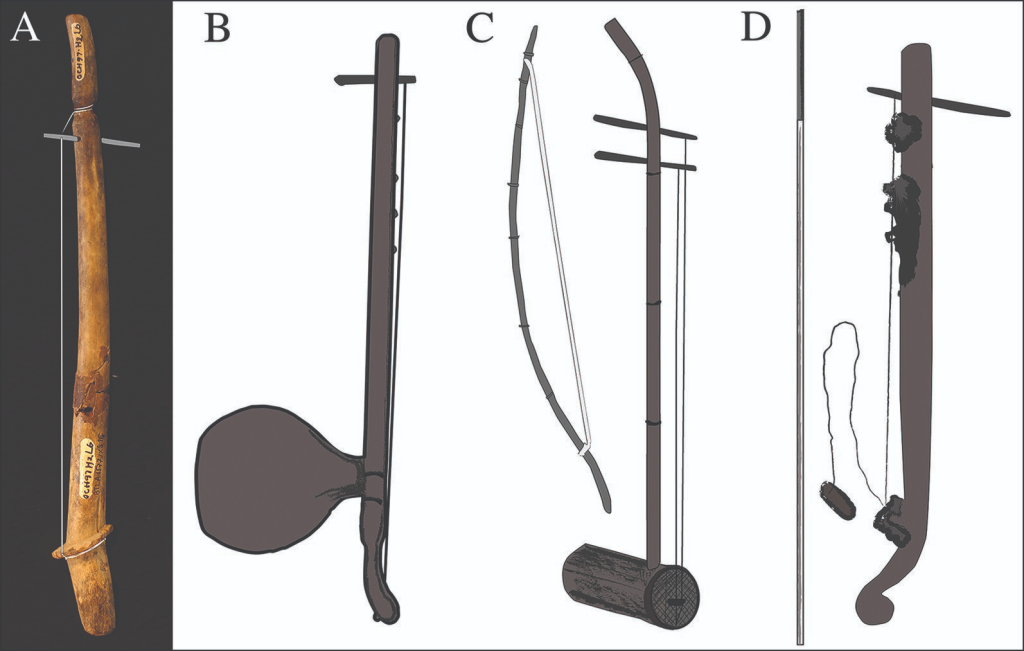The Birth of Musical Discovery
At some unknown point in prehistory, early humans stumbled upon the magic of musical sound. By stretching a thong between the horns of a dead animal or across the forked branches of a tree, they realized they could produce vibrant tones. Hunters also noticed that the bowstrings they used for hunting emitted a distinct pitch when plucked.
This early experimentation with stretched strings laid the foundation for countless musical advancements. Eventually, they discovered that altering the string’s length and thickness produced different pitches. This fundamental principle—tension, length, and vibration—became the cornerstone of stringed musical instruments.

The Creation of the First Stringed Instruments
The Harp: The Earliest Stringed Instrument
From these humble beginnings, the harp was born. Plucking taut strings attached to a frame created musical notes, leading to the development of more complex designs.
Interestingly, the shape of the modern piano’s frame follows the natural harmonic curve found in the harp, demonstrating the enduring influence of these early designs.
The Monochord: A Simple, Yet Revolutionary Tool
Another pivotal invention was the monochord. This device featured a single string stretched over a soundbox, with a movable bridge to adjust the vibrating length of the string.
Musicians would move the bridge to different marked positions on the soundboard to produce various notes. Though primitive, the monochord was an essential early step toward understanding musical scales and theory. Today, it might be compared to a basic tone measurement device or a simple experimental model for music students.
The Evolution of Stringed Instruments
The Psaltery: A Plucked Ancestor of the Harpsichord
In the 14th and 15th centuries, the psaltery gained widespread popularity across Europe. This shallow, closed box featured strings stretched across its surface, plucked either by fingers or small plectra.
Some versions of the psaltery were bowed rather than plucked, offering new expressive possibilities.
Its construction and plucking method positioned the psaltery as a clear forerunner of the harpsichord, where plucked strings would later create elegant, resonant music for royal courts and churches.
The Hammer Dulcimer: The Struck Predecessor to the Piano
At the same time, another instrument was evolving: the hammer dulcimer.
Believed to have originated in ancient Iran, predating Christ, the dulcimer featured strings stretched over a soundboard and struck with small wooden hammers.
Unlike the psaltery, which was plucked, the dulcimer’s technique more closely resembled the action mechanism that would later define the piano — hammers striking strings to create sound.
Though similar in appearance, the dulcimer and the psaltery served distinct musical functions and required different playing techniques. The dulcimer’s percussive nature, in particular, profoundly influenced the way instrument makers thought about sound production.
The Development of Musical Notation
Early Attempts at Notation in Rome
Around the first few centuries AD, musicians in Rome began experimenting with ways to record music.
Initially, their system was rudimentary, using simple curves or marks to suggest that the pitch should rise or fall. These early notations gave performers only vague guidance but were crucial first steps toward the written music we know today.
The Evolution into the Five-Line Staff
By approximately 1160 in Paris, the familiar five-line staff had begun to emerge, offering a much more transparent and standardized method of representing musical pitch and rhythm.
This revolutionary development allowed composers to communicate their musical ideas more precisely across great distances and generations.
The Refinement of Modern Notation in England
By 1400, English musicians had further refined the art of musical notation.
Open and closed note heads began to appear, and the system became strikingly close to what musicians use today.
Additionally, composers employed red ink—known as “coloration”—to indicate rhythmic variations. This creative solution enabled more complex and expressive compositions, laying the groundwork for the rich tapestry of Western music that would follow.
Preserving the Tradition: The Importance of Careful Instrument Handling
Understanding the ancient lineage of stringed instruments enhances our appreciation for modern pianos and keyboards.
Today’s pianos are not just instruments; they are the culmination of centuries of innovation, craftsmanship, and musical exploration. Each piano move must respect that legacy.
At Keyboard Carriers, we specialize in the careful, professional moving and storage of pianos and keyboards throughout Denver, CO, and surrounding areas. Whether you own a vintage upright, a delicate baby grand, or a modern concert grand, our experienced team treats every instrument with the respect and protection it deserves.
Contact Keyboard Carriers Today
Ensure your piano is handled by experts who appreciate its historical significance and intricate craftsmanship.
Contact Keyboard Carriers for all your piano moving and storage needs.
